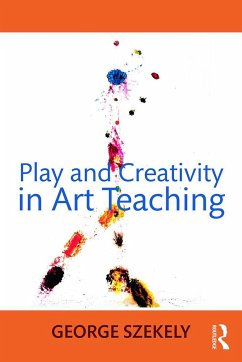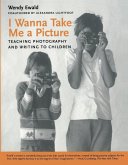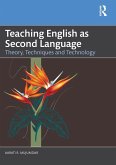George Szekely
Play and Creativity in Art Teaching
George Szekely
Play and Creativity in Art Teaching
- Broschiertes Buch
- Merkliste
- Auf die Merkliste
- Bewerten Bewerten
- Teilen
- Produkt teilen
- Produkterinnerung
- Produkterinnerung
In this new book for new times, esteemed art educator George Szekely merges into a single expanded and updated work his two classic volumes Encouraging Creativity in Art Lessons and From Play to Art. The book offer plans for the study of childrenà â â s play and for discovering creative art teaching as a way to bring play into the art room.
Andere Kunden interessierten sich auch für
![Art of Teaching Art Art of Teaching Art]() Deborah A. Rockman (Professor of Art in the Foundation and Fine ArtArt of Teaching Art40,99 €
Deborah A. Rockman (Professor of Art in the Foundation and Fine ArtArt of Teaching Art40,99 €![I Wanna Take Me a Picture I Wanna Take Me a Picture]() Wendy EwaldI Wanna Take Me a Picture37,99 €
Wendy EwaldI Wanna Take Me a Picture37,99 €![Teaching English as Second Language Teaching English as Second Language]() Aarati R MujumdarTeaching English as Second Language38,99 €
Aarati R MujumdarTeaching English as Second Language38,99 €![Peer Mentoring in Music Education Peer Mentoring in Music Education]() Andrew GoodrichPeer Mentoring in Music Education41,99 €
Andrew GoodrichPeer Mentoring in Music Education41,99 €![The Teaching of Instrumental Music The Teaching of Instrumental Music]() Richard J. ColwellThe Teaching of Instrumental Music67,99 €
Richard J. ColwellThe Teaching of Instrumental Music67,99 €![Dynamic Play and Creative Movement Dynamic Play and Creative Movement]() Judith PeckDynamic Play and Creative Movement41,99 €
Judith PeckDynamic Play and Creative Movement41,99 €![Arts Integration Arts Integration]() Merryl Goldberg (USA California State University San Marcos)Arts Integration89,99 €
Merryl Goldberg (USA California State University San Marcos)Arts Integration89,99 €-
-
-
In this new book for new times, esteemed art educator George Szekely merges into a single expanded and updated work his two classic volumes Encouraging Creativity in Art Lessons and From Play to Art. The book offer plans for the study of childrenà â â s play and for discovering creative art teaching as a way to bring play into the art room.
Produktdetails
- Produktdetails
- Verlag: Taylor & Francis Ltd
- Seitenzahl: 192
- Erscheinungstermin: 17. März 2015
- Englisch
- Abmessung: 229mm x 152mm x 11mm
- Gewicht: 286g
- ISBN-13: 9780415662536
- ISBN-10: 0415662532
- Artikelnr.: 41753568
- Herstellerkennzeichnung
- Libri GmbH
- Europaallee 1
- 36244 Bad Hersfeld
- gpsr@libri.de
- Verlag: Taylor & Francis Ltd
- Seitenzahl: 192
- Erscheinungstermin: 17. März 2015
- Englisch
- Abmessung: 229mm x 152mm x 11mm
- Gewicht: 286g
- ISBN-13: 9780415662536
- ISBN-10: 0415662532
- Artikelnr.: 41753568
- Herstellerkennzeichnung
- Libri GmbH
- Europaallee 1
- 36244 Bad Hersfeld
- gpsr@libri.de
George Szekely is Professor and Director of Graduate Studies in Art Education, University of Kentucky, USA, and is currently President-Elect of the National Art Education Association for a six-year term beginning May 2015. He was named a National Treasure by the National Art Education Association and presented with the honor of becoming a Distinguished Fellow. For his lifetime contributions to art education, he received the Victor Lowenfeld Prize and the Emanuel Barkan Award.
Preface
CHAPTER 1
Theory, Research, and Purpose
1.1 Introduction
1.2 Theories about Play
1.3 What is Play Art?
1.4 Play is Art
1.5 The Purpose of Playing in the Art Class
1.6 Creative Play
1.7 A General Outline of the Play-Based Class
1.8 Addressing Obstacles to Play and Art
1.9 The Stages of Creative Play
CHAPTER 2
Beginning the Art Lesson: Inspiration and Preparation
2.1 Traditional Art Skills versus Play Skills
2.2 Play as Preparation for Art
2.3 Lessons from Children
2.4 Play and the Search for Creative Ideas
2.5 Embracing the Mess
2.6 Creative Play Themes
2.7 What Play-Based Art Teachers Do
CHAPTER 3
A Classroom Environment for Play and Art
3.1 Classroom Environments for Play
3.2 Lessons from Home Studios
3.3 Children's Room Set Up for Play
3.4 The Doors to Art
3.5 Floors
3.6 Chairs
3.7 Tables
3.8 Playing Beyond the Art Room
CHAPTER 4
Materials for Play and Creativity
4.1 Materials for Play and Creativity: Thinking Beyond Traditional Art
Supplies
4.2 The Self-Serve Art Room
4.3 Shopping Sites in the Classroom
4.4 Shopping Sites: The Way Children Search for Materials
4.5 Toy Materials
4.6 Art Tool Materials
4.7 Tech Materials
4.8 Packaging Materials
4.9 Play Materials and Collections
4.10 Lessons from Experience
CHAPTER 5
Movement in Play and Art
5.1 Art and Inspiring Performances
5.2 Art in Movement
5.3 Art and Movement Play
5.4 Action Toys and Movement
5.5 Tech Toys and Movement
5.6 Traditional Tools and Movement
5.7 Playful Bodies
5.8 Dance Performances
CHAPTER 6
Themes of Art Play
6.1 Birthday Play
6.2 Adventure Play
6.3 Store Play
6.4 Building Play
6.5 Playing with Art
6.6 Pretending in an Art Class
CHAPTER 7
Creative Art Teaching
7.1 Best Practices for the Play-Based Art Teacher
7.2 Observing Play
7.3 The Classroom and Beyond
7.4 Just Making Things
7.5 Creative Conversation
7.6 Playing with Adults
7.7 Epilogue
Additional Resources on Play, Creativity, and Art
CHAPTER 1
Theory, Research, and Purpose
1.1 Introduction
1.2 Theories about Play
1.3 What is Play Art?
1.4 Play is Art
1.5 The Purpose of Playing in the Art Class
1.6 Creative Play
1.7 A General Outline of the Play-Based Class
1.8 Addressing Obstacles to Play and Art
1.9 The Stages of Creative Play
CHAPTER 2
Beginning the Art Lesson: Inspiration and Preparation
2.1 Traditional Art Skills versus Play Skills
2.2 Play as Preparation for Art
2.3 Lessons from Children
2.4 Play and the Search for Creative Ideas
2.5 Embracing the Mess
2.6 Creative Play Themes
2.7 What Play-Based Art Teachers Do
CHAPTER 3
A Classroom Environment for Play and Art
3.1 Classroom Environments for Play
3.2 Lessons from Home Studios
3.3 Children's Room Set Up for Play
3.4 The Doors to Art
3.5 Floors
3.6 Chairs
3.7 Tables
3.8 Playing Beyond the Art Room
CHAPTER 4
Materials for Play and Creativity
4.1 Materials for Play and Creativity: Thinking Beyond Traditional Art
Supplies
4.2 The Self-Serve Art Room
4.3 Shopping Sites in the Classroom
4.4 Shopping Sites: The Way Children Search for Materials
4.5 Toy Materials
4.6 Art Tool Materials
4.7 Tech Materials
4.8 Packaging Materials
4.9 Play Materials and Collections
4.10 Lessons from Experience
CHAPTER 5
Movement in Play and Art
5.1 Art and Inspiring Performances
5.2 Art in Movement
5.3 Art and Movement Play
5.4 Action Toys and Movement
5.5 Tech Toys and Movement
5.6 Traditional Tools and Movement
5.7 Playful Bodies
5.8 Dance Performances
CHAPTER 6
Themes of Art Play
6.1 Birthday Play
6.2 Adventure Play
6.3 Store Play
6.4 Building Play
6.5 Playing with Art
6.6 Pretending in an Art Class
CHAPTER 7
Creative Art Teaching
7.1 Best Practices for the Play-Based Art Teacher
7.2 Observing Play
7.3 The Classroom and Beyond
7.4 Just Making Things
7.5 Creative Conversation
7.6 Playing with Adults
7.7 Epilogue
Additional Resources on Play, Creativity, and Art
Preface
CHAPTER 1
Theory, Research, and Purpose
1.1 Introduction
1.2 Theories about Play
1.3 What is Play Art?
1.4 Play is Art
1.5 The Purpose of Playing in the Art Class
1.6 Creative Play
1.7 A General Outline of the Play-Based Class
1.8 Addressing Obstacles to Play and Art
1.9 The Stages of Creative Play
CHAPTER 2
Beginning the Art Lesson: Inspiration and Preparation
2.1 Traditional Art Skills versus Play Skills
2.2 Play as Preparation for Art
2.3 Lessons from Children
2.4 Play and the Search for Creative Ideas
2.5 Embracing the Mess
2.6 Creative Play Themes
2.7 What Play-Based Art Teachers Do
CHAPTER 3
A Classroom Environment for Play and Art
3.1 Classroom Environments for Play
3.2 Lessons from Home Studios
3.3 Children's Room Set Up for Play
3.4 The Doors to Art
3.5 Floors
3.6 Chairs
3.7 Tables
3.8 Playing Beyond the Art Room
CHAPTER 4
Materials for Play and Creativity
4.1 Materials for Play and Creativity: Thinking Beyond Traditional Art
Supplies
4.2 The Self-Serve Art Room
4.3 Shopping Sites in the Classroom
4.4 Shopping Sites: The Way Children Search for Materials
4.5 Toy Materials
4.6 Art Tool Materials
4.7 Tech Materials
4.8 Packaging Materials
4.9 Play Materials and Collections
4.10 Lessons from Experience
CHAPTER 5
Movement in Play and Art
5.1 Art and Inspiring Performances
5.2 Art in Movement
5.3 Art and Movement Play
5.4 Action Toys and Movement
5.5 Tech Toys and Movement
5.6 Traditional Tools and Movement
5.7 Playful Bodies
5.8 Dance Performances
CHAPTER 6
Themes of Art Play
6.1 Birthday Play
6.2 Adventure Play
6.3 Store Play
6.4 Building Play
6.5 Playing with Art
6.6 Pretending in an Art Class
CHAPTER 7
Creative Art Teaching
7.1 Best Practices for the Play-Based Art Teacher
7.2 Observing Play
7.3 The Classroom and Beyond
7.4 Just Making Things
7.5 Creative Conversation
7.6 Playing with Adults
7.7 Epilogue
Additional Resources on Play, Creativity, and Art
CHAPTER 1
Theory, Research, and Purpose
1.1 Introduction
1.2 Theories about Play
1.3 What is Play Art?
1.4 Play is Art
1.5 The Purpose of Playing in the Art Class
1.6 Creative Play
1.7 A General Outline of the Play-Based Class
1.8 Addressing Obstacles to Play and Art
1.9 The Stages of Creative Play
CHAPTER 2
Beginning the Art Lesson: Inspiration and Preparation
2.1 Traditional Art Skills versus Play Skills
2.2 Play as Preparation for Art
2.3 Lessons from Children
2.4 Play and the Search for Creative Ideas
2.5 Embracing the Mess
2.6 Creative Play Themes
2.7 What Play-Based Art Teachers Do
CHAPTER 3
A Classroom Environment for Play and Art
3.1 Classroom Environments for Play
3.2 Lessons from Home Studios
3.3 Children's Room Set Up for Play
3.4 The Doors to Art
3.5 Floors
3.6 Chairs
3.7 Tables
3.8 Playing Beyond the Art Room
CHAPTER 4
Materials for Play and Creativity
4.1 Materials for Play and Creativity: Thinking Beyond Traditional Art
Supplies
4.2 The Self-Serve Art Room
4.3 Shopping Sites in the Classroom
4.4 Shopping Sites: The Way Children Search for Materials
4.5 Toy Materials
4.6 Art Tool Materials
4.7 Tech Materials
4.8 Packaging Materials
4.9 Play Materials and Collections
4.10 Lessons from Experience
CHAPTER 5
Movement in Play and Art
5.1 Art and Inspiring Performances
5.2 Art in Movement
5.3 Art and Movement Play
5.4 Action Toys and Movement
5.5 Tech Toys and Movement
5.6 Traditional Tools and Movement
5.7 Playful Bodies
5.8 Dance Performances
CHAPTER 6
Themes of Art Play
6.1 Birthday Play
6.2 Adventure Play
6.3 Store Play
6.4 Building Play
6.5 Playing with Art
6.6 Pretending in an Art Class
CHAPTER 7
Creative Art Teaching
7.1 Best Practices for the Play-Based Art Teacher
7.2 Observing Play
7.3 The Classroom and Beyond
7.4 Just Making Things
7.5 Creative Conversation
7.6 Playing with Adults
7.7 Epilogue
Additional Resources on Play, Creativity, and Art









